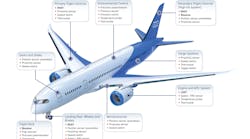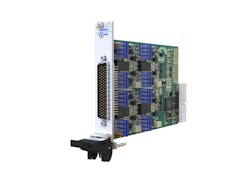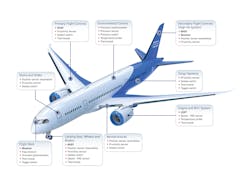We are in an era of advanced intelligent electronic systems, from IoT devices in the Cloud to next-generation EVs on the road. Regardless of the application spaces and solutions presented, they all have a common denominator in the need for advanced sensor integration. This means that electronic design engineers must be able to use the latest tools and procedures to empower the integration and optimization of the sensor suites needed to address modern needs.
To get a look into what some are doing to address the sensor integration and simulation issues, we reached out to Keith Moore and Paul Bovingdon at Pickering Interfaces, a creator and supplier of modular signal switching and simulation solutions for use in electronic test and verification for PXI, LXI, USB and PCI applications.
Keith Moore: I think the vast array of sensors that are available now, there's a huge range of sensors and they're getting more and more complex with time, enabling people to build so much more. Particularly on safety. To put so much safety into products now, so we could look at it. Many manufacturers can design, particularly transportation equipment, something that's got to be a hundred percent safe. But now they can build it, so it is virtually a hundred percent safe. We've seen this with aircraft, airlines for example. Where 50 years ago, they used to crash, unfortunately with regularity. Now it's amazing, unusual this is due to the sensors, that you can really sense any form of defect or early starting fatigue and so on and so forth. So you can build something that's virtually a hundred percent safe.
Paul Bovingdon: Well, not only that, Keith. I think we're entering an era in design and manufacturing where that sense of awareness starts with you at the design level. If you're not using active simulation, modeling, computer software, unless you're literally testing from transistor one, you're going to be behind the eight ball compared to your competition. The other side of that coin is now that we're extending awareness into the field, having that information, having those systems established properly will also ensure that these systems will function in the field and give you that telemetry to provide that customer support that's demanded today in advanced systems.
Keith Moore: I agree. I think the most obvious example of this... If you go back to aircraft, you used to see aircraft being designed in the 40s and 50s and they didn't know that test pilots need test pilots. These were brave guys because a lot of them didn't make it because a lot of these planes crashed. The early ones, it's very common to lose a few, but the prototype stage, it pretty much never happens now. Why is that? It's because they can simulate the whole airframe before it ever gets off the ground, before any pieces are put together.
You can test multiple faults, and the interesting part is, you can put in multiple faults, in the most bizarre and unusual situations. Now we all know that plane crashes are caused by multiple faults happening simultaneously. Now in the old days, we used to wait until that happened. We'd have to predict it or estimate it, don't need to do that now. You can simulate everything. So by the time the plane takes off, you can get the odd glitch, but the level of safety is so high compared to what we used to see back in the 50s and early 60s.
It's a huge improvement. And the other part of that is, particularly planes and so forth, have software upgrades. Now, I guess in the past, you give it a software upgrade and keep your fingers crossed when it took off, don't have do that anymore. You can simulate everything. So all these minor updates for software can be fully verified before the plane or the car or the train or the air engine, ever takes off.
Keith Moore: So why is simulation important in hardware-in-the-loop simulation? Sensors are embedded in the array of the transportation equipment, as I've mentioned planes, but also UAVs, spacecraft, automobiles, trains, ships, and frankly any other form of transportation equipment. Although there are other areas like industrial automation, there are an enormous range of sensors for measuring all types of parameters, pressure, temperature, strain, position, displacement, acceleration, vibration, et cetera.
Often these sensors are very specific, with hundreds of variants targeted, in very specific requirements and environments. Pickering has hundreds of PXI and simulation choices available, and we're continually adding to that range of products. Now Pickering's PXI simulation products are designed to replace many of these senses in hard-in-the-loop simulation systems. These applications often very complex, containing ever-increasing amounts of software code and are often updated frequently.
They're usually very safety critical. Hence the need to test and test and test to simulate all the possible simulation criteria that could go wrong. If software is loaded initially, but then often frequently updated. Now each time the software is updated, you need to run a simulation to make sure that everything happens that it should do, and also to run the possibility of putting in additional faults. So you can have a software update and then you can retest it by putting in multiple different types of faults at the same time, to make sure that the competed code does exactly what it's supposed to do.
Our PXI simulation products combined with certain modules are also very useful to replace sensors in automatic test equipment (ATE) applications. We've provided a picture of the typical kind of application here. Now these can be combined with a range of general purpose PXI switch modules. Those would be multiplexes, matrices and general purpose relays, to construct a complete ATE system with additional instrumentation. Now ATE applications include many senses needed to simulate different parts of testing, different parts of assemblies, sub-assemblies and printed circuit boards. So the result of the test system is smaller, faster, more, accurate, and more repeatable.
Ubiquitous Test
EE: Right, the thing is, is that also ties to the one of the other facets. I guess we're going to have to call it a gem, because it has more than two sides. So we can't call it a coin. But one of the other facets to all of this, as we were talking earlier about ubiquitous sensing. Through the entire process, in order to have Six Sigma in your manufacturing, you need to pretty much test at every manufacturing step or during the manufacturing step. The need for tests during manufacturing, post manufacturing, quality control is becoming even more critical.
Keith Moore: Definitely. Many of these simulation modules also have various special features required by very specific requirements for each of the modules. Because, for example, we look at temperature and often you've got to simulate different types of temperature monitors. So these could have very specific, or very wide temperature ranges. Sometimes we'll need a program resistor, which has got a very wide range. Other times it wants to be very narrow, but extremely accurate. And you've got to have real-time software support. We also add in, often short and open simulation, for example, typically for things like broken or frayed cables. As we know with aircraft, many of the crashes from years ago, used to be broken cables and such.
EE: Today designers are being forced to think of the gestalt of the entire system more.
Keith Moore: That's right, yeah. Because the complexity of all the subsystems is enormous.
Paul Bovingdon: You can simulate various different sensor types. You got the temperature, strain, light, force, and also level measurement. By using these kind of sensors, you can reduce the cost of the test system, because it replaces the need for actual real sensors, which also means you don't need the physical environment of the sensors. If you're using a real temperature sensor to test something, you're actually going to have to change the temperature of that sensor.
So obviously whereas with these, you don't. You just dial it in software and you don't need to worry about the environment. The other advantage is you have reuse between applications. Again, if you're using real sensors, you have to have the right sensor for application. Whereas if you have a resistor module with enough capability, you can repurpose it as and when needed. But also, it improves accuracy, speed and repeatability because you don't get the variation between sensors, it's calibrated. So you know what you're getting. This helps to reduce the complexity because you're not using discrete sensors. You don't have lots of separate wires going all over the place, you can do with cable bundles going through things. So it's a lot more manageable. It's also being confined within a fixed test Rackspace.
EE: How much does it let you get away from the test chamber? Does it allow you to eliminate it completely?
Paul Bovingdon: When you are simulating a sensor, you don't need environmental chambers. You don't need the real equipment. For example, if you are dealing with a large marine engine, as an example; if you can simulate the sensors or simulate the entire engine, you're going to need that there. With all the sensors connected to it. That is quite a large system. So you need to get things right the first time, you need to go for a cycle, whereas with simulation, you can speed the whole process up as well.
EE: How much of an oversight can you get on the entire system through a simulation, or at least using your simulation tools?
Paul Bovingdon: From the central point of view and also pressure and strain using the program or resistance, you can do a lot of it. For example, a spacecraft, it's very difficult to actually get it in the real environment because you've got to be plummeting through the atmosphere and all to get that. You can use programmable resistance instead, to simulate that. Obviously you need to actually have a profile of what you're simulating. I mentioned an engine before, you're going to have to know how the engine behaves in order to program your test system.
EE: Right, so there will be some hard testing required to at least get the parameters?
Paul Bovingdon: Yes, when it comes to the ATE that Keith was talking about, where you're actually testing control units, as an example. Generally you will know how it's being used, you will know how the system would ordinarily behave. So you can just mimic that system.
Paul Bovingdon: More recently, we expanded into other areas, the first one being thermocouple simulation. We've had a module for a number of years now. Earlier this month, we released the LVDT/RVPC Volver simulation module for simulating linear or rotational position and motion. And then coming up, I believe the end of this month, we'll be releasing our analog output, which is aimed at the current-loop simulation. So we'll simulate four to 20 milliamp industrial current loops, but it actually goes beyond that, it goes from 0 to 24, which current loops have for certain conditions and that kind of thing.
So if you focus on the thermocouple simulation for a minute, the uses in science and industry, there's many different types made up of different materials dependent on the application, the accuracy, the range, et cetera, for your environment. The applications can include temperature measurement, gas turbine, exhausts, diesel engines, and other industrial processes. The more recent thermocouple solution goes up to 32 channels, but obviously not everyone will necessarily need 32 channels. So we actually offer it in 24, 16, and other versions as well. That's basically a low voltage output module going up to plus or minus 100 millivolts, which will simulate any thermocouple that's likely to be simulated.
We have a resolution of 0.7 microvolts, in the lowest range of plus-minus 20 millivolts. It also has a two-wire output for each channel, which means we can actually have a fully-floating system. There's no common ground or anything like that. So we removed ground loops, also customers, when they use things like open thermocouple detection and things like that. By being in a fully-floating system, we don't interfere with that. So it behaves more like a real thermocouple from that point of view. Again, it also has open-circuit simulation as Keith mentioned before. We can simulate a broken wire as an example, or even a broken thermocouple, because obviously a thermocouple is just two soldered wires together, essentially. So we can simulate that. So then whatever's under test, the engineer can see how that equipment behaves in that sigma full condition.
So our particular LVDT/RVDT resolver simulation, it's a one new module. We can have... It comes in two or four banks. So you have fully populated, which is four or half of that which is two, again, given customer the options, depending on how many they actually need. You can have up to four channels of five and six wire simulation or up to eight channels with four wire simulation. On this, just like a real sensor, we actually have transformers on there for galvanic isolation.
So you don't need to worry about common grounds or anything like that. And again, we have built in full insertion relays to simulate opens and shorts. That's on the input and the output. So you can simulate the shorts on the supply. So both going into the module as well as the output. As a wider pricing frequency on a single module, unlike a lot of options out there, you can actually buy a single module and it will work anywhere from 300 Hz up to 20 kHz.
Generally you need to select a specific module in order to get the frequency bands you need and change the module between. To say in all offering, you can use a single module across that whole frequency range. We also offer customers to supply their own excitation signal into the front panel, or we can actually do it on board, so they don't need to worry about the signal generation. I've got an input excitation voltage up to 38 volts RMS into the module and an output of up to 31 volts RMS.
If we move on to our analog output and current loop simulator module. The reason why we have that is, it does have analog output. But it really is aimed at that current loop market. This designed to test industrial current loop transceivers in applications, such as process instrumentation, PID controllers, [inaudible 00:25:11] and PLCs. It makes the repeating requirements of industrial control applications, utilizing currently loops 4 to 20 milliamp. As I said before, the current loop is 4 to 20 milliamp, but in a lot of loops, you actually go from 0 to 24 in order to have extra full conditions and things like that.
It's ideal for 4 to 20 milliamp industrial current loops, as I mentioned. We actually have different outfit options. It's 4 to 20 milliamp. So just, the actual operating range of the current loop and go from 0 to 24 milliamps. It can also do plus and minus 24 milliamps. But not only current, we can actually have voltage outputs as well. So we have 0 to 5 volts plus or minus 5 volts and plus and minus 12 volts. So again, it can be used for various, different applications. It's self-powered. So it could be powered from the PXI back planes. The customer doesn't have to supply any power. However, it has the ability to have an external power supply to better simulate the current loop sensors that they may be working with.
We have up to 16 channels in a single PXI slot, and since they can supply their own power, they can work in a fully-isolated system again to avoid ground loops. We have 16-bit resolution, which means we can have a resolution of down to 1 microamp and an accuracy of 0.1% plus or minus the resolution. What our module has, which seems to be more unique is a programmable slew rate. So you can actually set how quickly you change from one setting to another. The big advantage this hides, is we can better simulate actual sensors or transceivers on the loop. They're not always ideal. They don't always behave the same.
So I prefer to better simulate the actual sensor. But also on top of that, if your sensor isn't really behaving properly, maybe, there's a short or something, so it's actually transitioning slowly. Again, having a programmable slew rate can simulate that, and then you can see how the controller behaves. Just like everything else, again, we have short and open simulation for those extra four conditions.
Solution availability
EE: What about access? One of the big things about these new, more powerful tools is it's bringing the power of tools that were only available to the select few that could afford them, to the more mainstream engineers. Are these solutions enabling the little guy to create world-class product?
Keith Moore: Probably one thing we haven't emphasized with this, is these kind of simulation tools have been around a long time. Actually since the 50s, when people actually really started to simulate, particularly airplanes. At that time and still today, most of the companies offering these, offer essentially a complete system. And I'm sure they're very good, but it is a complete system. And you're looking at a few hundred thousand dollars, million dollars plus for what is probably a very nice, very complete system.
Some of the larger aerospace companies make their own, manufacture their own systems. As you say, the little guy can forget it. There's no chance, unless he's got a very big bank account. The difference in what we're doing, is we're offering the modular solutions. So if they're existing PXI users, they can go and buy a bit of a chassis from NI or Keysight, whoever. They can put in some cards from those companies. They can add in the simulation products or switching products from us.
Going further than that. Pickering also have a range of very small chassis controlled by the USB or LXI, where you can just buy a thousand dollar chassis, put in a thousand dollar simulation card and you've got going. Okay, you still have to spend a few thousand dollars, but not much. And that's probably two or three orders of magnitude at a lower cost to start off with. Then you're going to be, if you go to some of the big guys who've been in the industry for 30, 40, 50 years.
EE: What would you leave our audience as a final thought?
Keith Moore: I don't see test developing a great deal more than it is already. Functional test has been around a long time. It's a very wide disparate market. Even small companies use a lot of ATE. That's relatively established. In simulation actually, it's quite different because as I've said before, there's been some big companies in simulation for a long time, but it's always been a closed system. Now with the perforation that beats control and all these vaster range of sensors, you're not just looking at an airframe or an aero engine or something where you want to do this kind of simulation. You want to do it in anything.
It could be a little robot vacuum cleaner, maybe it could even be a poster. The range of products where simulation could be done is enormous now. It's not just restricted to say air frames or cars or complex systems. It could be very simple systems. So if somebody else walked up to simulate, for example, something stupid like a toaster, they could do it using our products. What it means is that you can get into this enormous range of products that we'd never think of even having a computer inside them before.
Who 30, 40 years ago, was thinking that you'd have a toaster with a brain, it's ridiculous, it's absurd. But of course you do now because the cost is almost zero to do that. What was exciting if we're providing things that are used by space, launch companies and so forth, it really does spread everywhere to anybody making any form of machine that has any particular safety implications. Because often there's really hinging on safety. So for example, if maybe my mobile phone goes wrong, okay you throw it in bin and get another one and maybe you could do the same with your toaster. But if you've got maybe a hot fat fry, another really cheap domestic appliance. Well, yeah, that's got safety implications, goes wrong and burns your house down.
So for us, what's critical with this is, it's something that's really safety orientated, human safety. That tends to be more in transportation equipment, but transportation equipment is going everywhere, especially automobiles. Before, they used to be dumb. Now, most cars are intelligent and how long it's going to be because before the autonomous, probably Tesla's talking, going fully autonomous next year, we'll see if that happens or not. But we all know in five to 10 years, there'll be an awful lot of autonomous vehicles on the market. And simulation is absolutely fundamental to those products.




